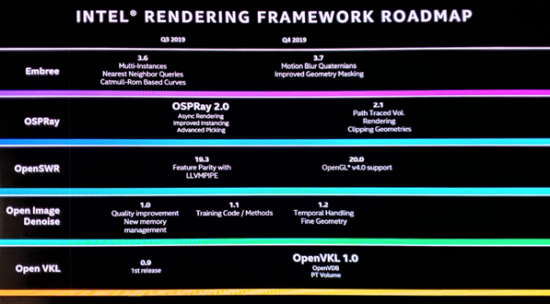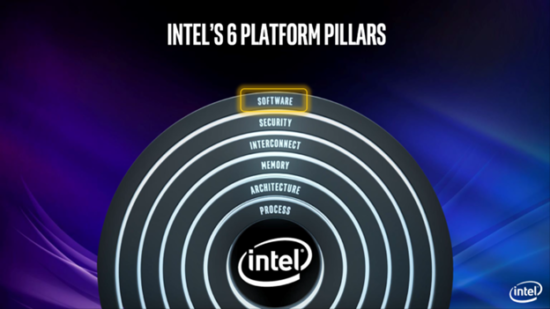Big content creation announced at Siggraph 2019.

At Intel’s inaugural Create event at Siggraph 2019, the company outlined its vision for rendering with exascale computing and oneAPI, and reiterated its six-pillars.
Jim Jeffers, Intel’s senior principal engineer and director of Advanced Rendering and Visualization, took the stage and after tricking us into believing Raja was a no-show, laid out the expectations of the presentations for the audience.
“The path to exascale computing and content creation have strong interdependencies and opportunities between them. The advancements we make in these areas can be readily shared across both domains to their mutual benefit,” said Jeffers, “Our investment in software initiatives like oneAPI, plus advanced algorithm research and development, plays a profound role as we set out to ‘leave no transistor behind’.”
Jefferies showed Intel’s Rendering Framework Roadmap, which spanned five technologies and at least two quarters.

Introduced in 2010, Embree, Intel’s ray tracing kernels, are in several programs and used for testing concepts of ray tracing for almost a decade. At Create, Intel revealed a major update, a new version of its ray tracing kernel (Embree 3.6) as well as a new Open Image denoising tool.
The Intel oneAPI Rendering Toolkit—used by more than 100 applications developed in-house and by ISVs today says Jefferies—is a set of highly optimized software libraries that enable efficient, high-quality rendering for data of virtually any size.
- Available now:
- Intel Embree v3.6 is the latest version of high-performance ray tracing kernels
- Intel Open Image Denoise v1.0 uses AI Deep Learning techniques to deliver leadership quality images to speed ray tracing applications’ rendering time
- Available by Q4:
- Intel OSPRay v2.0, the open-source, scalable, ray tracing engine, will incorporate Intel Open Image Denoise v1.0
- Intel Open Volume Kernel Library for volumetric rendering
OSPRay 2.0’s first iteration will have features such as asynchronous rendering.
Intel had its usual parade of partners take the stage to talk about their collaborations with Intel and its upcoming software stack.
Pixar talked about how it will enable Renderman to realize 2× acceleration of the Open Shading Language on Intel Xeon processors (using AVX 512) as well as its intention to utilize and extend R&D for Renderman to the upcoming Intel Xe GPU architecture.
Maxon revealed that it is using Intel Embree and Open Image Denoise in Cinema 4D R21 to deliver faster rendering times and announced a technical partnership for future CPU and GPU technology.
Otoy disclosed it will be supporting the Vulkan API going forward in Octane Render, citing the need for industry standards to take advantage of the best hardware available.
Other users of Intel technology gave an overview of the efforts.
- Discovery announced a new science education digital series, a new collaboration with Intel, coming this fall that will use the Intel oneAPI Rendering Toolkit to deliver stunning, high-fidelity visualizations to better educate viewers.
- HP demonstrated how Intel Optane DC persistent memory can be used to eliminate the need for slow and disruptive manual and/or auto-saves in content creation applications. Additionally, HP showed how persistent memory can be leveraged to preserve work history across application and system transitions, allowing creators to rapidly pick up where they left off.
- BlueSky Studios showed how large persistent memory can change the way creators work by enabling tasks that were simply not possible before, such as multi-TB rendering jobs.
The Intel oneAPI Rendering Toolkit—used by more than 100 applications developed in-house and by independent software vendors (ISVs) today—is a set of highly optimized software libraries that enable efficient, high-quality rendering for data of virtually any size. OneAPI is at the heart of Intel’s GPU ambitions, from it HD integrated to its forthcoming Xe discrete GPU family that will extend from entry-level notebooks, through gaming PCs and up to GPU compute clusters in the cloud and datacenter.
Exascale computing, says Jefferies, will unlock new opportunities for fast, high-quality rendering, physical simulations, and new AI-supported workflows, expanding creation possibilities in studios. Moving, storing, and processing data in these complex scenarios requires advancements across the computing spectrum, including architecture (CPU and GPU), memory, I/O and most importantly, the software that connects it to the artists.
“The path to exascale computing and content creation have strong interdependencies and opportunities between them. The advancements we make in these areas can be readily shared across both domains to their mutual benefit,” concluded Jeffers. “Our investment in software initiatives like oneAPI, plus advanced algorithm research and development, plays a profound role as we set out to ‘leave no transistor behind’.”

What do we think?
Intel plans total world domination of anything and everything graphics, as well as exascale computing—everything. No longer content to have just high-end Xeon processors in the cloud, data center, and workstations, the company wants to add “the other” processor to its stable of solutions. It’s about time Intel got over itself and recognized that one x86 doesn’t fit all. Now it has FPGAs for the tinkers, AI processors for the thinkers, x96 processors for everyone, and last but far from least GPUs, integrated and discrete for any application that can and does use them. Intel is all in, and truly is (or soon will be) offering one-stop shopping. Ya wanna flip some bits or save them, we gotcha covered, says Intel.





